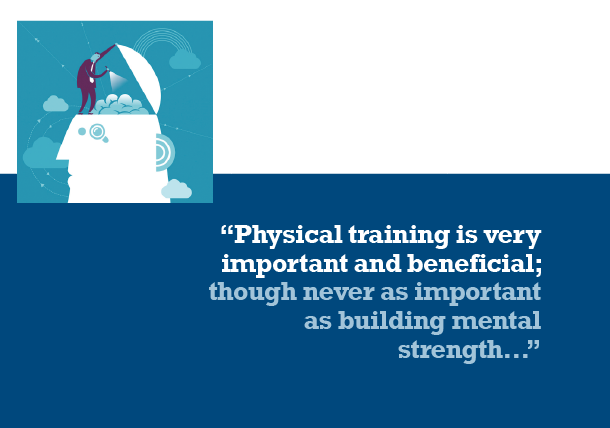Many people take to the gym to practice techniques and lift weights in a bid to build a stronger physique. Whilst developing a faster punch and a chiselled six-pack, they often ignore the most important part of training; the mental workout. Of course, physical training is very important and beneficial; though never as important as building mental strength.Building a strong mind takes time; some minds will be further down the road than others. Having an understanding of why and how we have these cocktails of emotions will erase some of the fear of fear. Understanding the mechanics of adrenaline release will take away some of its impetus. When we anticipate danger, we all experience this unpleasant, strong emotion often referred to as ‘flight or fight’ syndrome. This is genetically hard – wired in all animals and humans. It is part of our survival mechanism; a primal instinct that has kept our species alive since day one and kept us at the top of the food chain. Having a clearer understanding will greatly help us to deal and cope with these physiological changes.
The saliva glands will temporarily shut down causing a dry and/or pasty mouth. In today’s society, this is a common side effect experienced by those who are expected to give a public speech; think of the best man at the wedding, watch him move his food around the plate; his meal will be picked at or completely avoided. To our hunter-gatherer ancestors the dry mouth served a different purpose – modern man is no different. When we chew, saliva is excreted into the mouth, enzymes within the saliva helps us to breakdown and absorb nutrients within the food.
Many will have experienced a nervous or audible tremor when speaking in public. The anticipation of the quivering voice has halted many people from stepping out of their comfort zones. It says to anyone in any language, that you are scared. In a potentially threatening situation this could be your downfall and needs to be controlled.
Those who experience it will often become monosyllabic and have difficulty stringing a sentence together. This is because blood is drawn away from certain areas of the brain and pumped to major muscles in preparation for flight or fight; hence the reason for the saying ‘he was as white as a sheet.’ (pale face).
Tunnel Vision
For modern man this can be a help or a hindrance. Positively, it can help because it enhances your concentration. Negatively, it distorts our peripheral vision. Sadly, this is often why people get knocked out on the street. When faced with an aggressive predator our peripheral vision will be impeded as we focus on the threat directly in front of us; the victim often being sucker punched and never seeing it coming. Street thugs often use this to their advantage when setting up the pincer approach.
Sweaty Palms
Sweating from your palms often happens when we are anxious or anticipate danger. In fact, we sweat from many areas of the body when stressed but the palms are often the most obvious due to excessive rubbing of the hands. This is another side effect of adrenaline release and occurs to cool down our core temperature which rises rapidly in the face of danger. Other body language is often displayed in an attempt to cool down; splaying of the arms, as if carrying two basketballs under your arms to allow the sweat glands to open. This is often observed in the pre-fight ritual when two men face off – splaying of the arms combined with pushing the chest out to appear bigger.
Bowel Loosening
Digested food and fluid is no longer needed and is expelled (often rapidly) depending on the (perceived) level of threat. Again the uneaten (best man’s) meal at wedding is a good example. The amygdala doesn’t distinguish between the sabre-tooth tiger or public speaking; it’s a matter of perspective.
Auditory Exclusion
Many people who I have trained over the years have told me about the temporary loss of hearing they’ve experienced when attacked. I have also experienced this myself while competing in kickboxing tournaments. We see and hear with our conscious brain. This means that the visual cortex and audible cortex have to take turns to process information. When trying to function under extreme levels of adrenaline stress, audible information is often muffled, dulled or completely shut down. When the heart rate rapidly increases, this causes blood to rush through the eardrums (as well as many other parts of the anatomy). The speed at which it travels is so great that it cancels out what the person is hearing.
The Denial Response
This is often seen in extreme circumstances. A teenage girl I interviewed a few years back described horrific details of a sexual attack upon her. As the assailant pinned her to the ground she recalled how she said to herself, ‘I could stick the point of my key in his eye’, but immediately thought she could never bring herself to do such a thing. When in fact she had already actually done it, simultaneously gouging his other eye with her thumb. Thankfully this facilitated her escape.
Total Acquiescence
When large amounts of adrenaline are released within the bloodstream, it is often shocking, nauseating and misunderstood. When this happens it can evoke feelings of helplessness and abject terror. Many victims of abduction have experienced extreme fear of being raped and/or murdered. Complete hysteria or the freeze syndrome may also occur. Victims who have experienced these extremely traumatic situations often submit to their attacker because of this overwhelming explosion of emotions.
Adrenaline Release (fast and slow)
Slow secretion of adrenalin is more commonly experienced. However, it goes without saying that everyone will have experienced this on a daily basis. While recently teaching members of Dublin Fire Brigade, many members described to me how they always get a drop of adrenaline each time the alarm bell sounds. This can happen dozens of times during a shift.
Those with a more sedentary occupation may also feel a slow trickle of adrenaline when they think about asking the boss for a promotion or if someone cuts them off in traffic and yells at them out of the car window. Going to the dentist, a dispute with a neighbour, an upcoming exam; all can evoke slow secretion of adrenalin.
While adrenaline can add speed and strength to the body’s responses, it can also have an anaesthetic effect while dulling pain. The adrenaline dump also causes sensations very similar to those of real fear. Consequently, many people will freeze when they experience this.
Real fear is involuntary and happens when we are in pure survival mode. Cortisol levels will also be greatly increased during this time which helps to coagulate the blood in preparation for an attack on the soft tissue. Many people I have spoken to say they did things they don’t believe they had any control over and could never have prepared for such an event. Many areas of the brain are activated immediately; the amygdala, thalamus, hypothalamus and midbrain functions increase and basically say to the body, ‘we’ll take over from here.’
We must first acknowledge and accept that we all have feelings of fear. One of the biggest obstacles I come across when teaching (particularly men) is that the majority I meet are too scared to admit they are scared. My belief is ‘the harder the exterior, the weaker the interior’- fear of fear, if you will.
The bad news is that fear never goes away. But that’s good. We can learn to manage our fears in many ways. My own personal experience; there is no better way to overcome and manage fear than fear exposure itself.
Aidan Carroll is founder of Hard Target Self-Defence Systems. www.hardtargetselfdefence.com

